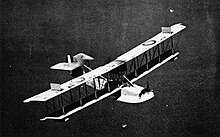Attack on Orleans
| date | July 21, 1918 |
|---|---|
| place | Orleans |
| output | German victory |
| Parties to the conflict | |
|---|---|
| Commander | |
|
unknown |
|
| Troop strength | |
| 1 submarine | 9 Curtis seaplanes |
| losses | |
|
no |
1 tugboat and 4 barges, 3 wounded civilians |
The German attack on Orleans was a bombardment of a small town and its port during the First World War . A submarine of the Imperial Navy attacked the city of Orleans on the Cape Cod peninsula in the US state of Massachusetts on July 21, 1918 and also shot at the small merchant ships in the port.
Bombardment
On the morning of July 21, 1918, the submarine U 156 positioned itself in front of Nauset Beach in Orleans, Massachusetts. The boat was equipped with two torpedo tubes , 18 torpedoes and two 15-cm guns with a supply of 1672 shells. The submarine appeared and first opened fire on the city and then with both torpedo tubes and the cannons on the approximately 37-meter-long tugboat Perth Amboy , which was surrounded by four wooden barges.
Men from the nearby US Coast Guard station stormed their observation tower and reported the attack to Naval Air Station in Chatham . After the tug was sunk, the submarine fired at the wooden barges. 32 sailors and civilians, including the wife and children of the tug captain, fled from the burning Perth Amboy and the barges.
The Curtiss HS-2L and R-9 seaplanes, arriving soon after, missed the submarine with their bombs.
consequences
After the successful raid, U 156 continued the hunt for Allied ships off the American coast. In Orleans, some craters and shells were found on the coast and in the nearby moor. The area itself suffered little damage, only the population was very impressed. People began to report sea battles off the coast. Others spoke of an alleged mother ship of U 156 . Newspapers ironically referred to the battle as the Battle of Orleans and offered a reward for finding a submarine base in Fundy Bay. The city also switched off all public lights for fear of German spies who would inform German submarines.
The attack on Orleans was the only Central Powers operation against the US mainland during the First World War. It was the first time since the siege of Fort Texas in 1846 that the mainland of the United States had been attacked. This happened again in 1942 when a Japanese Navy submarine shot at Fort Stevens on the Oregon coast during World War II .
See also
literature
- RH Gibson, Maurice Prendergast: The German Submarine War 1914–1918 . Periscope Publishing Ltd., 2002, ISBN 1904381081 .
- Bradley Sheard: Lost Voyages: Two Centuries of Shipwrecks in the Approaches to New York . Aqua Quest Publications, Inc., 1997, ISBN 1881652173 .
Web links
- uboat.net entry about U-156
- Michael Westaway McCue: The U-Boat That Threatened America. ( January 6, 2009 memento on the Internet Archive ) In: American History Magazine (February 2002), pp. 38-42.
- How little Jack defied the Imperial Navy

